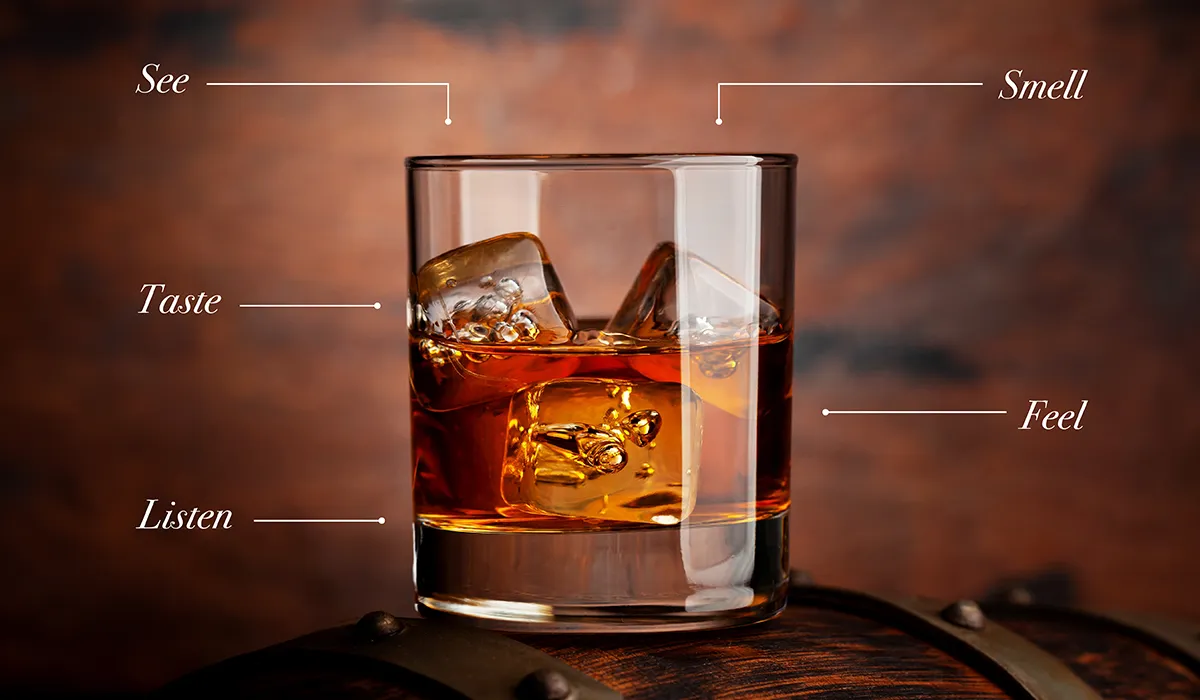Whisky isn’t just something you taste. You don’t just nose whisky. Learn how to experience it mindfully — using all of your senses.
Is whisky just a drink?
As you get more familiar with whisky, you start to realize it’s so much more. Whisky can be a time capsule that awakens warm memories. A conversation starter between friends. A star ingredient in a great meal. A guest of honour at our memorable occasions. And it earns this place in our lives thanks to the connection it makes through our senses — all of them.
Yes, to fully perceive and appreciate whisky, we have to use all five senses. We have to slow down and experience it mindfully.
And once you’re in the habit of enjoying whisky as a full-spectrum sensory journey, your appreciation rises to a new level. Ready to learn how it’s done? Grab yourself a dram (a new one, or a favourite you’re keen to rediscover) and follow along — starting with the pour.
See the whisky
You can begin to experience whisky as a sensory journey by paying attention to how it looks as you pour it into the glass.
Watch as it glistens in the light. (Relaxing lighting can contribute to an enjoyable whisky experience, by the way. The gentle, orangey illumination of dusk, a fireplace, or incandescent lamps all complement a whisky’s lovely warm hues — whereas harsh lighting, like fluorescent bulbs, washes them right out.)
Observe the colour — is it pale like a wheatfield? Or tawny gold like a sunset? The colour of whisky gives you clues to how it was matured. Often, Canadian, Scotch and Irish whiskies aged in ex-bourbon barrels can be a pale straw colour, for example. Virgin oak and ex-sherry casks can bring a darker complexion to whisky. Port and rum casks make it darker still, all the way to a reddish brown, like terracotta. And cask strength whiskies are often dark simply by virtue of being more concentrated. Within the world of Scotch, for example, observe how the gold straw colour of Chivas Regal 12 contrasts with the reddish copper of Aberlour A’bunadh. It’s like the difference between the golden hour and dusk — which, by the way, would be good times of day to enjoy each of them. (Because you may find lighter-bodied whiskies suit the daytime while heavier ones are best enjoyed after eating.)
Wherever your whisky sits on the spectrum, you have to admit: It’s beautiful.
Smell the whisky
Next it’s time to bring your nose to the whisky. Pay attention: Is that smoke? Apple? Citrus? Flowers? The range of aromas that whisky can exhibit is truly spectacular. Take a complex single pot still Irish whiskey like Yellow Spot, for example, which has been described as exhibiting mown hay and cracked black pepper. Not to mention red bell peppers, nutmeg, clove oil and green tea. Oh, and sweet honey and peaches. (Are we forgetting anything?)
Smell is how we experience so much of whisky’s complexity — it gives you more information than the other senses. (Our guide to nosing and tasting has more on this. It also shares practical advice for enjoying the whisky-tasting experience, so be sure to check it out.)
Let your nose linger, and meditate on the aromas. Be patient; they can take time to emerge. And when they do, they can take you places — to your past, to specific locales. Because smell and memory are deeply intertwined, the question “what does this whisky smell like?” is almost the same as asking, “what does this whisky remind me of?
So before you move on, ask yourself: Where and when is this whisky taking you?
Taste the whisky
At last, it’s time to taste the whisky. In some ways, our sense of taste is not as sophisticated as smell. Because your taste buds can only detect whether something is sweet, sour, salty, bitter or “umami,” taste may seem limited. Yet the combination of smell and taste is what we call “flavour,” and that is unlimited.
This explains why whisky takes on new dimensions as we sip it. The aromas you smelled become flavours that shift and sharpen. Smoke becomes a campfire. Apple morphs into apple pie. To see what we mean, try The Glenlivet 18 and try to observe how the citrus fruit in the nose sharpens into ripe, sweet orange on the palate. Or how the toffee in the nose becomes rich burnt caramel.
This is what whisky reviewers mean when they talk about how a whisky “develops” on the palate. And once again, the closer you pay attention, the more you’ll get from the experience.
Feel the whisky
Whisky is also a tactile sensation as you drink it. How does it feel on your tongue and in your mouth?
Cool and smooth? A “smooth” whisky flows easily, like a river. To experience this for yourself, sip a mellow and balanced blended Canadian whisky like Gooderham & Worts, or an Irish one like Jameson Original. Smooth whiskies are great at harmonizing with mixers, which is why they’re often partnered with soda, cola or ginger ale.
Or does your whisky burn sweetly? Does it prickle your tongue a little as it goes down? A whisky with a higher ABV sometimes feels “hot,” as you’ll notice the first time you try a cask strength whisky like Aberlour A’bunadh. You can do what many experienced whisky lovers do and “cool” stronger whiskies down by adding water (lightly chilled spring water is a popular choice). Still, others prefer the full burn of a cask-strength Scotch or a bourbon served neat. Some like it hot, as they say.
Another dimension of the “feel” of whisky is the length of the finish — that is, does the taste linger for a long time, or short? Some people even pull out a timer to see how long the finish lasts, but that could be considered spoiling the mood.
Listen to the whisky
OK, whisky doesn’t make a sound. We admit that.
But what you can do when you savour a whisky is make it a full-sensory experience by filling the room with conversation. And/or music. Some experts swear the music you hear while enjoying whisky influences how you perceive it.
Choose a genre of music that you find relaxing and stimulating at the same time — in other words, one that’s enjoyable and engaging just like whisky is. Depending on your taste and the whisky’s style, we recommend you choose:
Mid-20th-century jazz, especially the really complicated stuff. Think John Coltrane and Miles Davis; look for a “hard bop” playlist. This music, with its disjointed yet balanced rhythms and spiralling chord progressions, connects with whisky’s complexity, sublime moments and technical flair. It may pair especially well with Scotches, given their famous complexity.
Low-key soul. Something with smooth-but-funky bass and laid-back drums can share a wavelength with the flow and precisely calibrated balance of whisky. Smooth like Canadian and Irish whiskey.
Rootsy, folky music with a story to tell — look for playlists like “chill Celtic folk-rock” or “road trip Americana.” Music with a narrative connects with the way whisky blends moments of sweetness with bold, gritty and dramatic flavours. It can work especially well with bourbon or Irish whiskey.
Which whisky will engage your senses next?
Now that you’ve enjoyed one whisky as a full sensory immersion, see how the experience differs as you try it with another — and another. And why not get some guidance to help you choose what’s next, so you can get the maximum enjoyment out of your whisky journey?
Join The Drop Collective and you’ll have a companion for your whisky exploration — with helpful articles and knowledge, plus an insider’s heads-up on exciting new releases, delivered regularly to your inbox.


